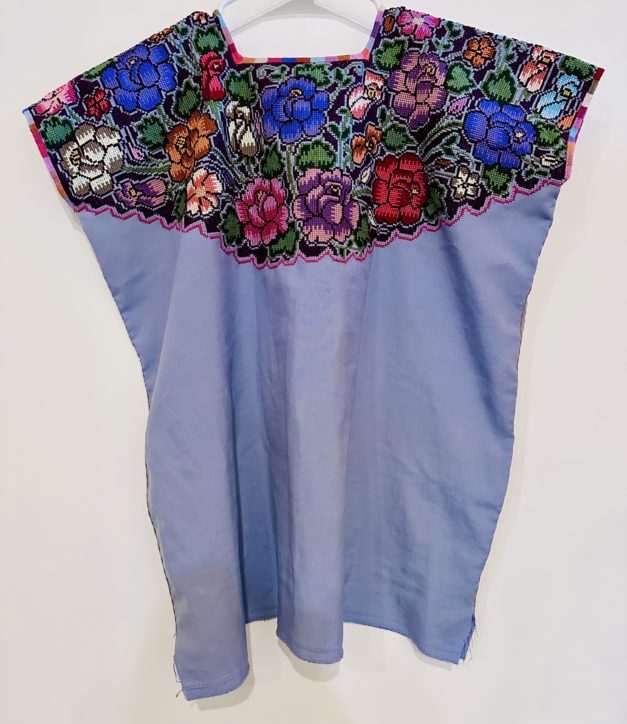Each Oaxaca village celebrates Day of the Dead a bit differently, according to their own customs. In Mitla, the spirits (difuntos) leave their tombs and follow the scents of copal and marigold back to the family homes on November 1. The transition from the underworld back to the world of the living happens in the morning and tradition has it that all have left their resting places by noon. This is when the firecrackers go off, the church bells ring, and all living relatives have left the cemetery in a procession, guiding the spirits with the intense aroma of incense and flowers.




Our group arrived at the cemetery at 11 a.m. in time to give prayers to Arturo’s mother Elena Quero Quero at her grave site. Arturo is a back strap and flying shuttle loom weaver who we have known for many years. We visit the Mitla cemetery with him for an explanation of the cultural history and traditions. Having a local friend to take us makes all the difference in how we are seen and accepted by locals, as well as enhances our learning experience.




We pay homage to two men from the USA who made Mitla their home in the mid-1900s, archeologist Ervin Frissell and artist Howard Leigh. They are both buried in a mausoleum at the cemetery and this is highly unusual. They are honored by the village and Oaxaca state because they were instrumental in collecting and documenting important artifacts that are part of the town’s cultural patrimony. In addition, Frissell introduced the fixed frame treadle loom here, bringing it from Saltillo, and taught women to weave shawls and make hand-knotted fringes. His hotel and restaurant attracted artists, writers, and archeologists from around the world. Frissell was the first outsider to come to help, according to Arturo, and the town reveres him.




We return to Arturo’s home studio for an explanation of his traditional altar and it’s significance for Day of the Dead. He uses only pre-Hispanic fruits and vegetables, uses a corn stalk instead of sugar cane (introduced by the Spanish) to create the portal to enter the living world from the underworld. He says there are more elaborate, luxurious altars, but this is how he personally wants to honor the ancestors. He tells us that the raised concrete altar was introduced by the Spanish. Before that, altars were on the ground.




Mitla is significant. It’s original name is Mictlan, place of the dead. It is believed that all Zapotec spirits eminate from here, a testimony that death is the most consequential event of life.
In the practice of blending Zapotec and Spanish tradition that we call syncretism, Arturo explains that the first arch of the concrete altar represents birth. The middle arch represents life and the one on the right represents death. The Catholics adapted the three portals to fit with their own spiritual beliefs and said the three portals represent the Trinity: Father, Son, Holy Ghost.


He shows us a new basket on the floor next to the portal. The spirits use this to collect the food from the altar to take with them when they return to the underworld. The basket must be new because it cannot occupy the spirit of anyone else! Alongside the altar is a petate, where the spirits can rest. The petate is a key part of ancient Zapotec life. This is where you are born, sleep, and wrapped with for burial. A man’s petate is tied closed with his sash. A woman’s is tied with her rebozo. The textiles help people cross over into the underworld.

Arturo serves us pulque, a lightly fermented juice from the agave plant. Different from mezcal, which is distilled, pulque is a viscous slightly sweet liquid that is a digestive cleanser, much like kombucha, and very important to indigenous culture for ceremonies.
He describes the mural behind the altar that shows the Mitla archeological site, the Catholic church built atop of these ruins, Spanish conquerors on horseback, birds that symbolize peace, native hairless Mexican dog called Xoloitzcuintli, a pre-Hispanic pastoral scene. Arturo says that the indigenous worshipped nature, water, and mother earth. The Spanish needed to conquer them spiritually.

After lunch next door at La Choza del Chef, we return to Arturo’s studio for a backstrap loom weaving demonstration and to see the beautiful textiles he and his son Martin create.


Next, we made a stop to visit Epifanio, another long-time friend in Mitla, who has constructed a very traditional altar amidst his collections of antiques that he buys and sells.

It was a great day of learning and exploring!







































































